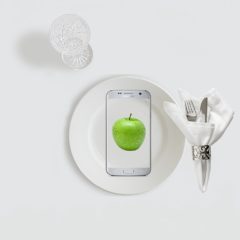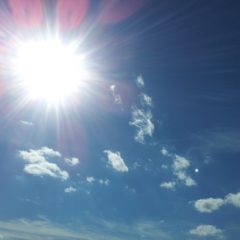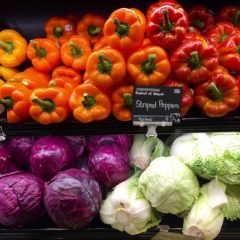A few weeks ago I woke up in the middle of the night with a really dry mouth. My dentist recommended a dry mouth spray for when that happens, so I reached out in the dark and took a couple of blasts of the spray, only to realize that what I had used was lavender air freshener instead. Gross! Luckily I was able to go right back to sleep, maybe because lavender is known for its relaxing properties.
The point is that water is an issue for me, and it’s too important of a nutrient not to be getting enough. In fact, it’s considered to be an essential 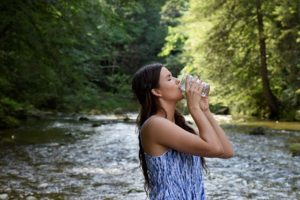 nutrient because your body needs more water than it can ever produce on its own. Think about it; you lose water every day through evaporation, elimination, respiration and sweating. You can live for quite a long time without food, but only for about three days without water. Here are a few of the things that water does for you:
nutrient because your body needs more water than it can ever produce on its own. Think about it; you lose water every day through evaporation, elimination, respiration and sweating. You can live for quite a long time without food, but only for about three days without water. Here are a few of the things that water does for you:
- It helps regulate your body temperature
- Water supports your digestion and keeps the process moving
- Water in the form of synovial fluid in your joints acts as a shock absorber and slows down wear and tear
- It’s crucial in controlling your blood pressure
- Water helps your immunity by flushing toxins from your body
- It helps balance your body’s electrolytes which regulate nerve and muscle function and maintains the acid balance (pH) in your body.
Experts vary widely in their recommendations of how much water you actually need to drink each day. Some recommend between four and eight cups (32-64 oz.) daily, while others say you need as much as 96 oz., which translates into 12 cups a day. What you actually need is specific to you, depending on your age, exercise levels, the medications you’re taking and your overall health. In addition, you need more water when it’s hot out, if you’re running a fever or if you’ve had an illness that causes diarrhea or vomiting.
While your brain tells you when you’re dehydrated and need water by feeling thirsty, your thirst isn’t a reliable gauge for when to drink. Thirst signals actually decrease as you get older, which means you need to make sure you’re getting enough water, whether or not you’re thirsty.
This is my problem. I’m just not thirsty, unless I’ve worked out for a long time on a hot day. And getting dehydrated isn’t a good thing. It can cause headaches, muscle cramps, and even sprains and muscle strains, because dehydrated tissues are more prone to injuries. For me, being dehydrated makes my mouth dry and is a powerful trigger for migraine headaches.
The question is how can you get enough fluids if you’re just not thirsty? Here are a few tips that may help if you also struggle to get enough water each day:
1) Set a goal for how much water you want to drink throughout the day. Make it realistic and achievable, and then track how you’re doing.
2) Try to drink the largest portion of water early in the day. Playing catch up late in the day is a recipe for lots of bathroom trips at night.
3) Carry a water bottle with you and sip constantly. This accomplishes a couple of things: it tells you how much you’re actually drinking, it can help you reach your daily goal and it serves as a reminder to drink. Without the guidance of thirst, your water bottle serves as a good reminder.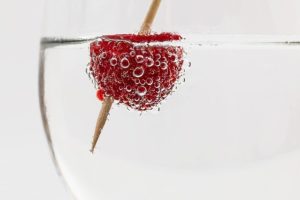
4) For some people plain water gets boring, especially when you’re not thirsty it in the first place. Try adding a little flavor, such as a wedge of lemon, lime or orange; bits of strawberry or raspberry, cucumber or add a small amount of juice to your water.
5) If your water tastes outright bad, try a water filter. You can get one that attaches to your tap or a pitcher that filters the water before you drink it. A good filter removes chlorine and contaminants from your water, including lead.
6) Eat hydrating foods. This includes soup and water-dense fruits and vegetables, such as melons, lettuce, cucumbers, strawberries, peaches and citrus fruits.
7) Wrap drinking water into your routine. Just like you brush your teeth when you get up in the morning (you do this, right?) you can schedule to drink during or after certain activities. For example, you could plan to drink when you first get up, before each meal, after a walk or workout and while you’re making dinner. You know your routine, so schedule what works best for you.
8) A couple of things to avoid are alcohol and sugary drinks. Alcohol is actually dehydrating. And fruit juices or sugary drinks are too…um, loaded with sugar to be healthy.
The bottom line is that being dehydrated isn’t good for you. It can lead to kidney problems, urinary tract infections, kidney stones, low blood volume, fatigue and dizziness. I am one of those people who have to work at drinking enough and you may be, too. Without the signal of thirst, it’s helpful to have workarounds and reminders. In the time it took me to write this, I drank a 12 oz. glass of water. Baby steps!
